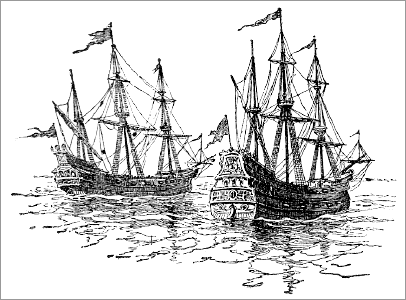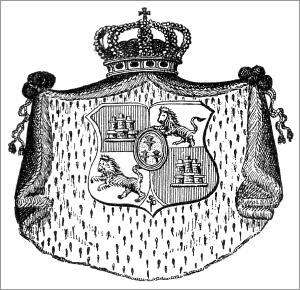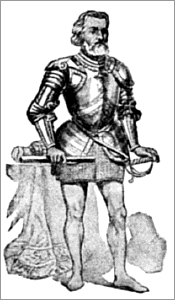| Home > Floripedia > De Leon, Ponce | |
De Leon, Ponce
A History of Florida1904
An Indian Myth. The Indians used to say that the white men first came from the foam of the ocean thrown upon the beach. After lying awhile in the sunshine the foam melted away, and white men were seen where it had lain. They arose and walked forth into the interior. A pretty story, and one that no doubt the Indian children liked to hear and tell. Perhaps Florida children of today may like as well the true story of how the discoverers came. It is an old story now.
Ponce de Leon. One of the companions of Columbus on his second voyage was Juan Ponce de Leon, a Spanish gentleman, as brave a soldier as any of that band who came over the great Ponce de Leon ocean in search of adventure. Instead of returning to Spain, he remained at Hispaniola.
He conquered the island of Porto Rico for Spain and was rewarded for his services by having his command taken away. Yet he could not remain long in idleness, and determined to go forth again in quest of honor and glory.
Tell the Indian legend of the coming of the white men. What is told of the position and character of Ponce de Leon? Why and when did he cross the ocean?
Rumors of a Fountain of Youth. Now, while his plans were still undecided, he heard from the Indians of an island called Bimini, where there was much gold and a treasure even more precious than gold—a fountain whose waters would make young forever all mortals who should drink of it. Many wonderful discoveries had been made since Columbus had proved the world to be round, and people were ready to believe anything. So the gray haired old warrior had no trouble in getting a commission from the king of Spain to conquer Bimini and take possession, for the crown, of the land with its marvelous treasure. The commission was given in 1512, and he was to settle Bimini within three years after its discovery.

Spanish ShipsThe Expedition for Bimini. At his own expense he fitted out three small vessels for the expedition, and found men eager to join him. He could not sail as soon as he had expected on account of some trouble with the Indians at Porto Rico, which detained him there until early in the next year.
Discovery and Landing. Sailing in the spring of 1513, he cruised among the Bahamas, for in that group he expected to find Bimini. Failing in his search, and hearing land in the northwest, he steered in that direction. It was on Easter Sunday, March 27, that he sighted land, and after coasting along the shore for several days, landed a little north of where St. Augustine now stands.
Florida Named. The Bahama Indians had called this land Canico, or Canicio. But on account of the beautiful flowers everywhere to be seen, or because the discovery was made on Easter Sunday—called by the Spaniards Pascua Florida—De Leon gave the name Florida to the country. He raised a cross and planted the Spanish flag, thus taking possession for the Spanish crown.
Explorations and Return. He made some exploration of the country, and cruised about the coast for several weeks. He discovered and named the chain of islands which he called the Martyrs, as well as the Tortugas, and even sailed a little way up the western coast. But nowhere could he learn anything of the fabled fountain he was seeking, nor did he find either gold or silver. Much discouraged, he returned to Porto Rico.
Another Expedition Planned. Just what the king thought of the value of the discovery we cannot tell, but new lands seemed always welcome. At any rate, he bestowed upon De Leon the very grand title of Adelantado, governor of Florida, and coil, comissioned him to conquer and colonize, with an army of three hundred men, the new territory for the crown of Spain. He was to begin the enterprise in one year, and within three years explore the country. But again De Leon was delayed at the West Indies, for the Indians of those islands had risen against the Spaniards, and his aid was needed.
Miruelo's Expedition. Meanwhile, since the way bad been shown, others were making voyages. In 1516 Diego Miruelo, a pilot with one vessel, made his way from Cuba to Florida, and sailed up the west coast, trading with the natives. He discovered a beautiful bay, supposed to be that afterward called Pensacola. He obtained some gold from the natives, and when he took this back to Cuba and told of the beauty of the country he had visited, many persons were eager to go there.

Spanish Coat of ArmsCordova lands. In 1517, according to some writers, Fernandez de Cordova landed on the western shore of Florida, but was surprised by an attack from a large band of hostile Indians. Six Spaniards were wounded and one was killed. Cordova himself afterward tired of wounds received. The Spaniards were glad enough to return to Cuba without seeing any more of the new country.
Pineda's Explorations. Though this expedition had failed, one of the party gave such an account of the riches and beauty of the country to the governor of Jamaica, Don Francisco de Garay, that he sent an expedition of three vessels under Pineda to learn more of it. The natives were no more friendly to Pineda than they had been to Cordova, and though he landed twice, he was each time obliged to return to his boats for safety. He sailed up the Gulf coast and then west, passing the mouth of the Mississippi and as far west as the river Panuco in Mexico.
De Ayllon. The next year, 1520, De Ayllon, a Spanish officer from San Domingo, fitted out two vessels, really for the purpose of taking the Indians as slaves. Cruising along the Atlantic shore, be learned much of the coast north of the St. Johns River. He told wonderful stories of a province in the present limits of South Carolina where the royal family were made giants by a process only understood by certain skillful doctors and nurses. He told also of a race of men who were said to have tails like horses. Perhaps he was thinking of the stories of the centaurs he must have read at school. Some years later De Ayllon tried to make a settlement on the spot where Jamestown was afterward built. But there was famine as well as sickness. De Ayllon died the first winter, 1526, and the colony was broken up.
Gomez. There was still another Spanish exploration of the coast; for in 1524 Emperor Charles V. sent Gomez to examine the coast south from Labrador to learn if there was any strait north of Florida by which vessels could reach the Indies. All these voyages proved that Florida was part of a large continent, but De Leon always thought of it and wrote of it as an island.

Spanish SoldierDe Leon attempts a Conquest. As time passed, De Leon's ambition was aroused by various expeditious of which be heard, and most of all by Cortez's triumphs in Mexico, and he determined to make the conquest of Florida. He laid out all his fortune in fitting out two vessels to bear him self and his companions to Florida. This was in 1521. The voyage was a rough, stormy one, but at last the Florida coast was reached and a land made. De Leon intended making a settlement, and had brought with him colonists and domestic animals for their use. Priests to teach Spanish Soldier the Indians were with him.
Warlike Indians. But there was no welcome from the Indians. The "children of the sun" soon found themselves among a fierce and warlike people. The Spaniards had hardly landed when they were violently attacked. Many were killed and the rest forced to return to their ships. Ponce de Leon, fighting bravely, was wounded by an arrow. All thought of conquering and settling Florida was now given up, and the return voyage to Cuba was begun.
De Leon's Death. Soon after reaching Cuba, the brave, disappointed old knight died of his wounds. "A lion by name and stilt more so by nature," is the translation of the Latin inscription of his monument, so great was his reputation for courage and daring.
Source:
Excerpt from Part One, Chapter One, "How Ponce De Leon Discovered Florida" A History of Florida, 1904. Next Section; Table of Contents.
| Home > Floripedia > De Leon, Ponce |
Exploring
Florida: A Social Studies Resource for Students and Teachers
Produced by the Florida Center for Instructional
Technology,
College of Education, University of South Florida © 2005.